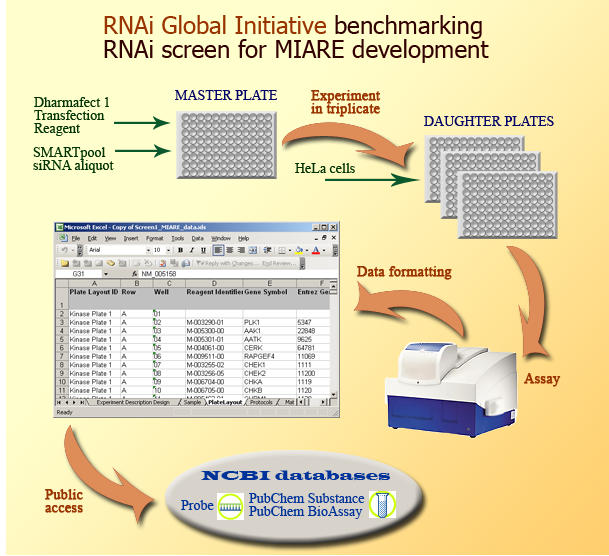 |
 |
||||||
   |
|
|
RNAi Global
|

Genome-Wide RNAi Global InitiativeHigh-throughput RNAi loss-of-function screening in mammalian cells has become a valuable method to identify and describe genetic relationships in both basic biology and disease mechanisms. See: Technology RNAi primer MissionThe RNAi Global Initiative is an alliance of leading international research centers under the 09:02:36 AM Wed, Sep 08 2010auspices of Dharmacon, Inc. Its goal is to combine the powerful technology of genome-wide RNAi screening with international scientific data exchange in order to accelerate and facilitate basic biological and medical discovery. Challenges
ApproachBuilding on established standards such as MIAME (Minimum Information About a Microarray Experiment), the RNAi Global Initiative has contributed work towards a community-wide effort known as the Minimum Information About an RNAi Experiment (MIARE). MIARE was initiated to develop universal reporting standards and guidelines that would facilitate the exchange, analysis and annotation of data derived from RNAi-based screens. To facilitate the development of the MIARE guidelines, ten member laboratories of RNAi Global conducted a multi-center siRNA benchmark screening experiment targeting 859 genes (779 genes of the phylogenetically related protein kinase family and 80 cell cycle genes) using two common assays: CellTiter-Blue® (Promega) and Apo-ONE® Homogeneous Caspase-3/7 (Promega). Sudy design
Reporting GuidelinesMIARE is intended to be modular so that it may be coupled or readily integrated with related standards such as MIACA (Minimum Information About Cellular Assay). Below are MIARE sections that need to be described while reporting an experiment. Detailed specifications for each section can be found at http://www.miare.org.
ProbeSample QueriesResources» Haney SA. Increasing the robustness and validity of RNAi screens. Pharmacogenomics. 2007 Aug;8(8):1037-49. PMID: 17716236 » Echeverri CJ, Perrimon N. High-throughput RNAi screening in cultured cells: a user's guide. Nat Rev Genet. 2006 May;7(5):373-84. PMID: 16607398 » Brazma A, Krestyaninova M, Sarkans U. Standards for systems biology. Nat Rev Genet. 2006 May;7(5):373-84. PMID: 16847461 » Whetzel PL et al. The MGED Ontology: a resource for semantics-based description of microarray experiments. Bioinformatics. 2006 Apr 1;22(7):866-73. Epub 2006 Jan 21. PMID: 16428806 |
Questions or Comments?
E-mail the NCBI Service Desk
